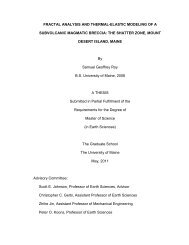Responses of Benthos to Changing Food Quality and Quantity, with ...
Responses of Benthos to Changing Food Quality and Quantity, with ...
Responses of Benthos to Changing Food Quality and Quantity, with ...
You also want an ePaper? Increase the reach of your titles
YUMPU automatically turns print PDFs into web optimized ePapers that Google loves.
<strong>Responses</strong> <strong>of</strong> <strong>Benthos</strong> <strong>to</strong> <strong>Changing</strong> <strong>Food</strong> <strong>Quality</strong> <strong>and</strong> <strong>Quantity</strong> 247<br />
In looking at these patterns one sees a peculiar melange <strong>of</strong> theory <strong>and</strong><br />
empirical pattern analysis, <strong>with</strong> little direct connection between the two .<br />
One exception that soon should emerge will be the issue <strong>of</strong> body size . One<br />
might expect deep-sea deposit feeders <strong>to</strong> be larger than their shallow-water<br />
counterparts, because metabolic cost per gram <strong>of</strong> flesh goes down <strong>with</strong> body<br />
size . Body size models such as those <strong>of</strong> Sebens (1987), however, show that<br />
this cost must be balanced against gain, i .e ., one must know how rate <strong>of</strong><br />
collection or digestive production scales <strong>with</strong> body size . Hessler <strong>and</strong> Jumars<br />
(1974) suggest that small deposit feeders can better focus food collection on<br />
interfacial sediments <strong>and</strong> thus get food <strong>of</strong> higher quality than can a bigger<br />
animal <strong>with</strong> a bigger collec<strong>to</strong>r . Penry <strong>and</strong> Jumars (1987) suggest that small<br />
body size avoids diffusional constraints on rates <strong>of</strong> digestion <strong>and</strong> absorption .<br />
Body size models have the potential <strong>to</strong> explain <strong>and</strong> <strong>to</strong> predict how biomass<br />
will be distributed among body sizes <strong>and</strong> how fast each <strong>of</strong> the individuals<br />
will process sediments . There are certainly strong patterns <strong>to</strong> explain<br />
(Schwinghamer 1985) ; the challenge is <strong>to</strong> couple mechanistic, predictive<br />
theory <strong>to</strong> them .<br />
Motility patterns also change <strong>with</strong> water depth <strong>and</strong> distance from shore .<br />
Frequent <strong>and</strong> intense sediment transport precludes sessility, as does a food<br />
flux so low that an animal cannot encounter sufficient food <strong>to</strong> sustain itself<br />
by staying put . Hence, an intermediate-depth maximum in sedentariness <strong>of</strong><br />
the fauna is expected <strong>and</strong> observed (Jumars <strong>and</strong> Fauchald 1977) . One also<br />
sees the anticipated demise <strong>of</strong> active benthic suspension feeders <strong>and</strong><br />
decreasing abundance <strong>of</strong> passive suspension feeders <strong>with</strong> depth, except<br />
where horizontal fluxes <strong>of</strong> ses<strong>to</strong>n are unusually high . Feeding type changes<br />
can be much more subtle, however, as a look at the life habits among the<br />
tube-dwelling polychaete worm family Ampharetidae demonstrates (Fig . 3) .<br />
In the high-energy intertidal, ampharetids build no special devices for<br />
capturing sediments <strong>and</strong> show no special adaptations for getting rid <strong>of</strong> their<br />
fecal matter ; the former are supplied in abundance while the latter are<br />
removed regularly by waves <strong>and</strong> currents . In lower-energy subtidal <strong>to</strong> bathyal<br />
<strong>and</strong> abyssal sites, ampharetids make pits that enhance sedimentation locally<br />
by inducing settlement or retention <strong>of</strong> horizontally transported material, <strong>and</strong><br />
they show much more care in keeping such feeding pits free <strong>of</strong> their own<br />
feces (Nowell et al . 1984) . At the deepest, most food-poor abyssal sites,<br />
ampharetids disappear al<strong>to</strong>gether . One gets the impression that it may be<br />
possible in the next decade <strong>to</strong> build models that predict what lifestyles will<br />
occur under what rates <strong>of</strong> organic rain <strong>and</strong> horizontal transport .<br />
A striking anomaly in the typical pattern <strong>of</strong> abundance change <strong>with</strong> depth<br />
has recently been discovered at the base <strong>of</strong> the continental rise (approx .<br />
4800 m) <strong>of</strong>f Nova Scotia (Thistle et al . 1985) . This region, studied under<br />
the HEBBLE (High Energy Benthic Boundary Layer Experiment) program,
















